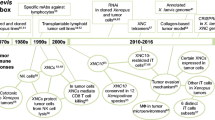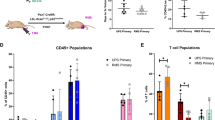Abstract
The heat shock proteins (HSPs) gp96 and hsp70 can elicit potent anti-tumor responses and as such have significant clinical potential. Besides cytotoxic CD8 T cell (CTLs) effectors, evidence suggests that natural killer (NK) cells and other less well-characterized cell types also play a critical role in HSP-mediated anti-tumor responses. Owing to their high degree of phylogenetic conservation, we have proposed that HSPs are ancestral agents of immune surveillance; and postulated that their immunological properties, if important, should have been conserved during evolution. We are investigating this issue using a unique non-mammalian comparative tumor-immunity model in the frog Xenopus, which allows us to focus on the relationship between HSPs, classical MHC class Ia, and non-classical MHC class Ib molecules. In addition to a transplantable lymphoid tumor in genetically defined cloned Xenopus, we are generating transgenic frogs with inducible or knocked-down (RNAi) gene expression.


Similar content being viewed by others
References
Hendrick JP. Hartl FU molecular chaperone functions of heat-shock proteins. Annu Rev Biochem. 1993;62:349–75.
Srivastava P. Interaction of heat shock proteins with peptides and antigen presenting cells: chaperoning of the innate and adaptive immune responses. Annu Rev Immunol. 2002;20:395–425.
Calderwood SK, Theriault JR, Gong J. Message in a bottle: role of the 70-kDa heat shock protein family in anti-tumor immunity. Eur J Immunol. 2005;35:2518–27.
Strbo N, Oizumi S, Sotosek-Tokmadzic V, Podack ER. Perforin is required for innate and adaptive immunity induced by heat shock protein gp96. Immunity. 2003;18:381–90.
Elsner L, Muppala V, Gehrmann M, Lozano J, Malzahn D, Bickeböller H, et al. The heat shock protein HSP70 promotes mouse NK cell activity against tumors that express inducible NKG2D ligands. J Immunol. 2007;179:5523–33.
Robert J, Ménoret A, Basu S, Cohen N, Srivastava P. Phylogenetic conservation of the molecular and immunological properties of the chaperones gp96 and hsp70. Eur J Immunol. 2001;31:186–95.
Baker-LePain JC, Sarzotti M, Fields TA, Li CY, Nicchitta CV. GRP94 (gp96) and GRP94 N-terminal geldanamycin binding domain elicit tissue nonrestricted tumor suppression. J Exp Med. 2002;196:1447–59.
Nicchitta CV. Re-evaluating the role of heat shock protein-peptide interactions in tumor immunity. Nat Rev. 2003;3:427–32.
Seliger B, Abken H, Ferrone S. HLA-G and MIC expression in tumors and their role in anti-tumor immunity. Trends Immunol. 2003;24:82–7.
Du Pasquier L, Schwager J, Flajnik MF. The immune system of Xenopus. Annu Rev Immunol. 1989;7:251–75.
Greenhalgh P, Olesen C, Steiner L. Characterization and expression of recombination activating genes (Rag-1 and Rag-2) in Xenopus laevis. J Immunol. 1993;151:3100–10.
Chrétien I, Marcuz A, Fellah J, Charlemagne J, Du Pasquier L. The T cell receptor b genes of Xenopus. Eur J Immunol. 1997;26:780–91.
Haynes L, Cohen N. Further characterization of an interleukin-2-like cytokine produced by Xenopus laevis T lymphocytes. Dev Immunol. 1993;3:231–8.
Sato K, Flajnik M, Du Pasquier L, Katagiri M, Kasahara M. Evolution of the MHC: isolation of class II ß-chain cDNA clones from the amphibian Xenopus laevis. J Immunol. 1993;150:2831–43.
Shum BP, Avila D, Du Pasquier L, Kasahara M, Flajnik MF. Isolation of a classical MHC class I cDNA from an amphibian: evidence for only one class I locus in the Xenopus MHC. J Immunol. 1993;151:5376–86.
Flajnik MF, Du Pasquier L, Cohen N. Immune responses of thymus/lymphocyte embryonic chimeras. Studies on tolerance and MHC restriction in Xenopus. Eur J Immunol. 1985;15:540–7.
Harding FA, Flajnik MF, Cohen N. MHC restriction of T cell proliferative responses in Xenopus. Dev Comp Immunol. 1993;17:425–37.
Robert J, Gantress J, Rau L, Bell A, Cohen N. Minor histocompatibility antigen-specific MHC-restricted CD8 T cell responses elicited by heat shock proteins. J Immunol. 2002;168:1697–703.
Kobel HR, Du Pasquier L. Production of large clones of histocompatible, fully identical clawed toads (Xenopus). Immunogenetics. 1975;2:7–91.
Watkins D, Harding F, Cohen N. In vitro proliferation and cytotoxic responses against Xenopus minor histocompatibility antigens. Transplantation. 1988;45:499–502.
Horton J, Manning MJ. Response to skin allografts in Xenopus laevis following thymectomy at early stages of lymphoid organ maturation. Transplantation. 1972;14:141–50.
Robert J, Guiet C, Du Pasquier L. Lymphoid tumors of Xenopus laevis with different capacities for growth in larvae and adults. Dev Immunol. 1994;3:297–307.
Robert J, Guiet C, Du Pasquier L. Ontogeny of the alloimmune response against transplanted tumor in Xenopus laevis. Differentiation. 1995;59:135–44.
Maniero G, Robert J. Phylogenetic conservation of gp96-mediated antigen-specific cellular immunity: new evidence from adoptive cell transfer in Xenopus. Transplantation. 2004;78:1415–22.
Binder R, Han D, Srivastava PK. CD91: a receptor for heat shock protein gp96. Nat Immunol. 2000;1:151–5.
Basu S, Binder R, Ramalingam T, Srivastava PK. CD91 is a common receptor for heat shock protein gp96, hsp90, hsp70, and calreticulin. Immunity. 2001;14:303–13.
Marr S, Goyos A, Gantress J, Maniero GD, Robert J. CD91 up-regulates upon immune stimulation in Xenopus adult but not larval peritoneal leukocytes. Immunogenetics. 2005;56:735–42.
Robert J, Ramanayake T, Maniero G, Morales H, Chida S. Phylogenetic conservation of gp96 ability to interact with CD91 and facilitate antigen cross-presentation. J Immunol. 2008;180:3176–82.
Robert J, Maniero G, Cohen N, Gantress J. Xenopus as an model system to study evolution of HSP-immune system interactions. In: Srivastava P, editor. Methods: a companion to methods in enzymology (HSP-Immune System Interactions) Ed. Academic Press; 2004, vol. 32, p. 42–53.
Goyos A, Gantress J, Cohen N, Robert J. Anti-tumor classical MHC-unrestricted CD8 T-cell cytotoxicity elicited by the heat shock protein gp96. Eur J Immunol. 2004;34:2449–58.
Gomes AQ, Correia DV, Silva-Santos B. Non-classical major histocompatibility complex proteins as determinants of tumour immunosurveillance. EMBO Rep. 2007;8:1024–30.
Salter-Cid L, Nonaka M, Flajnik MF. Expression of MHC class Ia and class Ib during ontogeny: high expression in epithelia and coregulation of class Ia and lmp7 genes. J Immunol. 1998;160:2853–61.
Stewart R, Ohta Y, Minter R, Gibbons T, Horton TL, Ritchie P, et al. Cloning and characterization of Xenopus beta2-microglobulin. Dev Comp Immunol. 2005;29:723–32.
Flajnik MF, Kasahara M, Shum BP, Salter-Cid L, Taylor E, Du Pasquier L. A novel type of class I gene organization in vertebrates: a large family of non-MHC linked class I genes is expressed at the RNA level in the amphibian Xenopus. EMBO J. 1993;12:4385–96.
Goyos A, Guselnikov S, Nedelkovska H, Robert J. Involvement of nonclassical MHC class Ib heat shock protein-mediated anti-tumor responses. Eur J Immunol. 2007;37:1494–501.
Allen BG, Weeks DL. Transgenic X. laevis embryos can be generated using phiC31 integrase. Nat Methods. 2005;2:975–9.
Sinzelle L, Vallin J, Coen L, Chesneau A, Du Pasquier D, Pollet N, et al. Generation of trangenic Xenopus laevis using the sleeping beauty transposon system. Transgenic Res. 2006;15:751–60.
Ogino H, McConnell WB, Grainger RM. Highly efficient transgenesis in Xenopus tropicalis using I-SceI meganuclease. Mech Dev. 2006;123:103–13.
Pan FC, Chen Y, Loeber J, Henningfeld K, Pieler T. I-SceI meganuclease-mediated transgenesis in Xenopus. Dev Dyn. 2006;235:247–52.
Chesneau A, Sachs LM, Chai N, Chen Y, Du Pasquier L, Loeber J, et al. Transgenesis procedures in Xenopus. Biol Cell. 2008;100:503–21.
Acknowledgments
The expert animal husbandry provided by Tina Martin and David Albright is gratefully appreciated. This research was supported by NIH F31-AI068610 (A. G.), T32-AI 07285 (H. N.), and R01-CA-108982-02, R24-AI-059830 (J. R.).
Author information
Authors and Affiliations
Corresponding author
Rights and permissions
About this article
Cite this article
Robert, J., Goyos, A. & Nedelkovska, H. Xenopus, a unique comparative model to explore the role of certain heat shock proteins and non-classical MHC class Ib gene products in immune surveillance. Immunol Res 45, 114–122 (2009). https://doi.org/10.1007/s12026-009-8094-9
Published:
Issue Date:
DOI: https://doi.org/10.1007/s12026-009-8094-9




